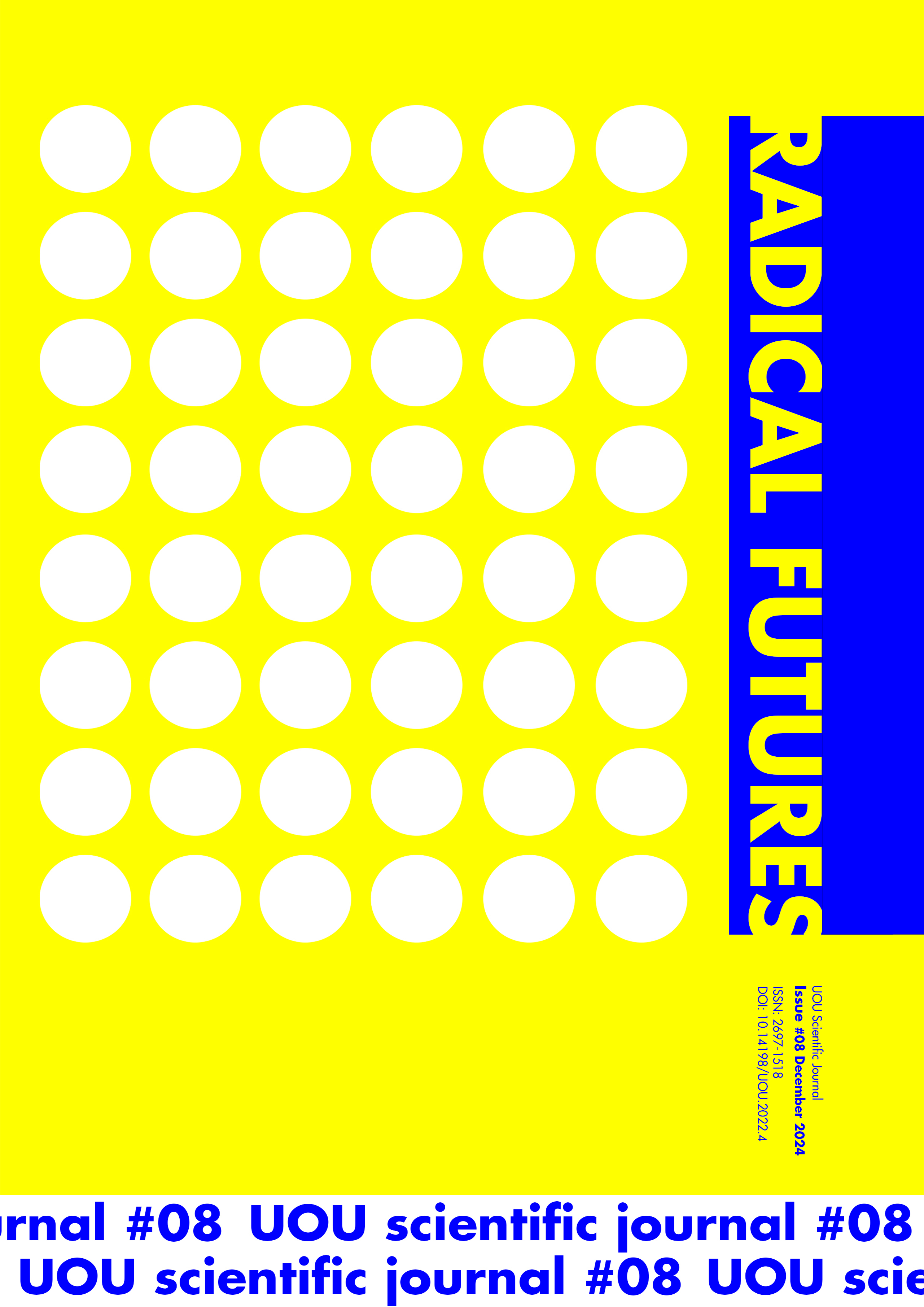CALL UOUsj#8 / RADICAL FUTURES

- May 23: OPEN CALL
- September 15: FULL PAPER Submission DEADLINE
- October 01: notification of PEER REVIEW Evaluation
- November 01: Final Submission DEADLINE
RADICAL FUTURES
The shape of a city changes faster, alas! than the heart of a mortal (Baudelaire, 1991)
Radical Architecture is, according to Maigayrou, a “current of research less concerned with the practice of the architectural profession than with reflecting on the bases, the foundations of architecture”[1] and we can identify it (in the current dizzying world of instant consumption of images) with projects such as the Pneumacosmos (Haus Rucker Co, 1967), the Continuous Monument (Superstudio, 1969) or the No Stop City (Archizoom, 1970).
This represents a fleeting but energetic period that was essentially deployed in Europe between the years 1960 and 1975 with the purpose of thinking about the architectural discipline from its origin (hence its essential, fundamental nature), displacing the understanding of the craft from the architect's routine as a builder towards the expanded territory of reflection on the world and the architect's competence to interpret it and act in it.
To this heterogeneous movement belongs a generation distanced from modernity and without direct involvement in the Second World War but located in the complex morass of a post-industrial world identifiable with production and communication on a planetary scale; a scenario of change and suspicion that legitimizes the end of all idealistic vision, the fall of the optimistic and teleological modern project for the advent of the real with its contradictions and defects.
Radical projects manifest this confusion in practices that are rarely “constructive” but transgressive, critical, and committed. Sometimes legible from the nearby world of the second artistic avant-garde (Pop Art, Minimalism, Land Art, Performance Art...), political-social criticism, the mediation of the body or environmental concern and activism.
All of this is intended to confront the world they’ve received by making its paradoxes visible and revealing the absurdity of a discipline that continues to insist on defining itself from formal and stylistic aspects to deviate towards a factual, operational architecture that acts on the real... even if it does not build anything (especially not building anything).
Radical Futures aims to achieve a contemporary understanding of this critical mindset, extend the limits of radical architecture and urbanism, and embrace the emergence of new practices supported by unconventional approaches from design, urbanism and technology.
This Call for Papers invites authors to re-connect architecture and criticism, understanding their theoretical borders from within the discipline. Nonetheless, interdisciplinary expressions and research through the proposed but not limited “radicalism” and keywords listed below:
- Radical definitions
- The relationship between architecture and critical thinking
- What is the purpose of architecture?
- Non-buildable architectures (for our own good)
- Indiscipline as a radical strategy
- Radical urbanism
- City, symbolism, and representation
- Non-buildable cities (for our own good)
- Contemporary radical cities or: Is radical urbanism possible today?
- Contemporary Supersuperficies
- Radical scales
- S, M, L y XL cities
- Appliance architecture
- Radical furniture design
- Utopian and dystopian architecture
- Airborne, multisensorial, and psychological architecture
- Inflatables and playful devices
- Contemporary Mind expanders
- Temporary radical structures
- Performative architecture
- Architecture, urban planning, and art
- Radical urban art
- Radical collages
- Contemporary Restless spheres
- Playful devices
- Radical Technology
- Artificial Intelligence, VR / MR / AR / XR / Metaverse / NFT / Web 3.0 for radical technology
- New software applications to radical concepts
- Radical pedagogies and education
- Student radical approaches to architecture and urban planning
- New conceptual pedagogies for a radical education
References:
- Baudelaire, Charles. Las flores del mal. Madrid: Alianza Editorial; 1991.
- Jarauta, Francisco. Arquitectura Radical. Las Palmas de Gran Canaria: La Imprenta editorial; 2002.
Authors are invited to submit papers for Issue #08 on Radical Futures in the UOUsj published by the University of Alicante (Spain).
UOUsj is the scientific peer-reviewed journal of UNIVERSITY of Universities and investigates the sharing of intercultural interests explored in international schools of architecture in close connection with the arts. Every issue underlines a specific topic addressed by one of the universities involved in the Research Project.
Therefore, we encourage contributions related to the result of pedagogical experiences and contributions that have emerged from other research in and around the topic of Radical Futures in the disciplines of architecture, urbanism, radicalism, conceptual architecture, art, and associated areas of study.
[1] Jarauta, Francisco. Arquitectura Radical. Las Palmas de Gran Canaria: La Imprenta editorial; 2002
The Editorial team includes professionals based in different institutions and countries:
Guest Editor Issue #08
- Miguel Luengo Angulo, Adjunct Professor of Architecture, Universidad Europea de Madrid (Spain) / miguel.luengo@universidadeuropea.es
Associate Editors:
- Joaquín Alvado Bañón, Alicante University (Spain)
- Michael Devereux, University of the West of England Bristol (UK)
- Sarah Stevens, University of Brighton (UK)
- Charlotte Erckrath, Bergen School of Architecture (Norway)
- Angela Kyriacou Petrou, University of Nicosia (Cyprus)
- Marco Bovati, Politecnico di Milano (Italy)
- Anna Moro, Politecnico di Milano (Italy)
- Daniele Villa, Politecnico di Milano (Italy)
Editorial Director
- Maria Luna Nobile, Umeå University (Sweden)
Editor-in-Chief
- Javier Sánchez Merina, Alicante University (Spain)
SUBMISSION GUIDELINES:
https://revistes.ua.es/uou/author-guidelines
PEER REVIEW PROCESS:
https://revistes.ua.es/uou/peer-review-process
INDEXINGS
Multidisciplinary databases
Specialized databases
Evaluation resources
- Latindex
- ERIH PLUS
- Agenzia Nazionale di Valutazione del Sistema Universitario e della Ricerca (ANVUR), Italia
- NORWEGIAN REGISTER FOR SCIENTIFIC JOURNALS, SERIES AND PUBLISHERS
- Sherpa Romeo
Other quality indicators
- Google Scholar
- Matriz de Información para el Análisis de Revistas (MIAR)
- Repositorio Institucional de la Universidad de Alicante (RUA)
For any information you can contact the Guest Editor, Miguel Luengo Angulo, at:
miguel.luengo@universidadeuropea.es
BIBLIOGRAPHY
-Archizoom. No-Stop-City. Milán: Domus; 1971
-Branzi, A. Una generazione esagerata. Dai radical italiani alla crisi della globalizzazione. Milán: Baldini&Castoldi; 2014
-Colomina, B y Buckley, C. Climp Stamp Fold. The radical architecture of Little magazines 196x to 197x. Barcelona: Actar; 2010
-Cook, P. Experimental architecture. Nueva York: Universe books; 1970
-Gargiani, R y Lampariello, B. Superstudio. Bari: Laterza; 2010
-Gargiani, R. Dall’onda pop alla superficie neutra. Archizoom associati 1966- 1974. Milano: Mondadori Electa; 2007
-Haus Rucker Co. Haus Rucker Co. Londres: Architectural Design; 1971b
-Jarauta, F. Arquitectura Radical. Las Palmas de Gran Canaria: La Imprenta; 2002.
-Koolhaas, R y Mau, B. SMLXL. Italia: Evergreen; 1995
-Luengo Angulo, Miguel. La Arquitectura Radical. Cinco puntos para una redescripción teórica. Buenos Aires: Diseño; 2020
-Navone, P y Orlandoni, B. Architettura “radicale”. Segrate: Documenti di Casabella; 1974
-Pettena, G. Radicals. Architettura e design 1960/75. Firenze: Il Ventilabro; 1996
-Superstudio. The 12 ideal cities. Tokio: Toshi Jutaku Urban Housing; 1971b












